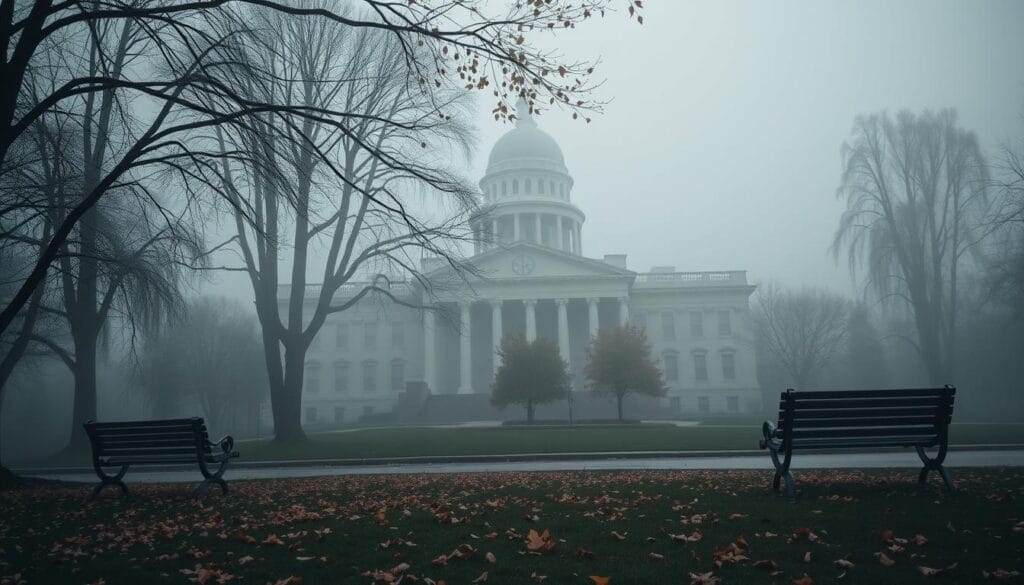Federal Grant Pause, The Latest Information did you know
Federal Grant Pause, Did you realize that the recent government grant halt might have an impact of trillions of dollars? Millions are now uncertain as a result of this action. It affects 7 million Pell Grant recipients and more than 40 million Americans who have federal student loans.

The pause affects more than just education. States, which get about 30% of their money from the federal government, are struggling. For example, Kansas expects $664 million, nearly 40% of its budget, from federal funds.
This pause will disrupt healthcare, research, and refugee assistance. Many are now looking for ways to cope with these changes.
Federal Grant Pause, Important Takeaways
- Trillions of dollars could be impacted by the federal grant pause.
- Over 40 million Americans with federal student loans are affected.
- Approximately 7 million Pell Grant recipients face uncertainty.
- States rely on federal funds for about 30% of their revenues.
- Programs for refugee aid, research, and healthcare are interrupted.
Breaking News: Federal Grants Paused Across Multiple Agencies
This has left many groups in a tough spot. The halt in federal assistance is causing worry for communities across the country.
Nonprofits, schools, and state governments are unsure about their future. They rely on these funds to operate. The pause in grant eligibility has created a lot of uncertainty.
Federal Grant Pause, Key Agencies Affected by the Pause
Affected departments include the Department of Housing and Urban Development, the Department of Education, and the Department of Health and Human Services. There is currently uncertainty surrounding programs such as school meals for low-income kids and federal Pell Grants.
Wildfire preparedness initiatives are also in limbo. The Office of Management and Budget wants detailed information from agencies by February 10. This adds to the complexity of the situation.
Initial Response from Government Officials
Government officials have different views. Some say it’s about being fiscally responsible. Others worry about the harm to vulnerable groups.
The Senate Appropriations Committee is looking into the pause’s effects. Critics say it’s unprecedented and could be very harmful. You also read the article about Disney’s Moana Lawsuit: All the Details You Need to Know
Immediate Impact on Current Recipients
Groups already getting federal funds are facing big problems. The National Head Start Association says there are delays in payments to staff and contractors.
Programs for child care, cancer research, and opioid addiction treatment are also at risk. The National Low Income Housing Coalition is urging members to speak out against the freeze.
- Federal Pell Grants and school meal programs are paused.
- Payments to Head Start staff and contractors are delayed.
- Programs for housing, disaster relief, and addiction treatment face uncertainty.
To mitigate the impact of the hiatus, they should also seek alternative financing sources.
Federal Grant Pause, Understanding the Scope of the Federal Grant Freeze
In many regions, the government grant moratorium has created a great deal of uncertainty. Delays in funding possibilities could cause numerous programs and services to be disrupted. Trillions of dollars in government expenditure are thought to be at risk, impacting states, cities, hospitals, schools, and families nationwide.
Diane Yentel, a well-known advocate, called it a “5-alarm fire for nonprofits,” showing how serious it is. The freeze affects all federal financial assistance programs, even those that have already been awarded but not yet spent. This means that grant applications are on hold, which could delay important projects and services.
“The deluge of calls to Senate offices reflects the widespread anxiety over this funding pause,” said a spokesperson.
Here’s a breakdown of the potential impact:
- Medicaid, food stamps, and disaster assistance programs face uncertainty.
- Essential services like education and healthcare could experience delays.
- Nonprofits and small businesses may struggle to maintain operations.
While Medicare and Social Security are safe, the bigger picture is quite scary. Legal challenges under the Impoundment Control Act of 1974 are expected, making things even more complicated. As we deal with this pause, it’s important to understand its full scope to prepare and lessen its effects.
Federal Grant Pause, Primary Reasons Behind the Government Funding Hold
The government funding pause has sparked many questions. It has stopped several programs, leaving many unsure about their financial futures. Three main reasons—legislative, administrative, and budgetary—have led to this pause.
Legislative Factors
Legislative issues have been a big part of the pause. The Trump administration wants to check if federal programs work well.
Administrative Challenges
Administrative problems have also played a role. The Office of Management and Budget (OMB) wants to make the grant process smoother. Agencies must have senior officials to follow presidential policies, making things more complex.
Budgetary Considerations
Budget issues are another key factor. The federal budget deficit is $1.8 trillion in fiscal year 2024. The pause helps review financial aid programs to use resources better.
“All federal spending must comply with the Administration’s priorities,” stated Matthew Vaeth, acting director of the OMB.
These reasons explain why government funding is on hold. It affects areas like healthcare research and disaster relief. As agencies face a February 10 deadline, the future of federal grants is still unclear.
Timeline of Events Leading to the Grant Suspension
The federal grants paused on January 27, 2025, marking a significant shift in funding programs suspended across multiple agencies. This decision, announced late in the evening, took effect at 5 p.m. the following day. This left many organizations scrambling to adjust.
- January 27, 2025: The announcement of the funding programs suspended was made, citing the need for a comprehensive audit of federal spending.
- February 10, 2025: Federal agencies were required to submit detailed information on affected programs, including those with grant eligibility on pause.
- March 14, 2025: A continuing resolution is set to expire, with spending levels determined by lawmakers.
The pause has left many organizations, including schools, hospitals, and non-profits, in a state of uncertainty. This affects thousands of families and communities nationwide.
As we navigate this period of grant eligibility on pause, it’s essential to stay informed and prepared for potential changes in federal funding policies.
Impact on Different Sectors and Organizations
The federal government’s recent move to suspend funding programs has caused big problems across many areas. With no federal help, groups that get grants are really struggling. This affects schools, research groups, charities, and local governments in different ways.
Educational Institutions
Universities and colleges are facing delays in getting funding for research and improving facilities. Many projects that rely on federal grants are now waiting, which is slowing down learning and planning.
Research Organizations
Scientific research groups are hit the hardest. Without federal help, important studies and tests are being delayed. This could slow down progress in health, tech, and environmental science.
Non-profit Organizations
Charities that help people in need are finding it hard to keep going. The lack of funding means they can’t support the communities they serve.
State and Local Governments
Projects to improve public services and infrastructure are at risk. Governments must now rethink their budgets and plans because of the pause in grants.
Current Status of Pending Grant Applications
The federal grant freeze has left many organizations in limbo. Funding opportunities are postponed indefinitely. Grant applications on hold are causing widespread uncertainty, affecting those relying on federal support.
Recent reports show the pause has disrupted timelines. Applicants are now unsure of when or if their funding will be approved.

- All federal financial assistance activities must cease by 5 p.m. on January 28, 2025.
- Grant review panels scheduled for the week following the pause announcement have been canceled.
- Agencies must submit lists of ineligible funding recipients by February 10, 2025.
Organizations are now assessing their cash flow models. They are preparing for different scenarios. The National Council of Nonprofits has called this situation a “5-alarm fire” for nonprofits and their communities.
This will further complicate the timeline for resolution.
For now, the focus remains on navigating this unprecedented disruption. Organizations are exploring alternative funding sources to mitigate the impact of the federal grant freeze.
Alternative Funding Options During the Pause
With the federal grant freeze in place, many groups are looking for new ways to fund their work. The delay in financial aid has made things tough, but there are ways to get through it. We’ll look at state grants, private funding, and emergency loans to help you get by.
State-Level Grants
State governments give out grants for education, research, and community projects. These can be a big help when federal grants are not available. Check your state’s website for funding options that have been delayed at the federal level.
Private Funding Sources
Private foundations and companies offer grants and sponsorships for specific areas. Groups focused on research, non-profits, and schools can find support here. Talking to industry leaders can lead to these funding chances.
Emergency Financial Solutions
For quick fixes, think about emergency loans or lines of credit. These can help out until federal grants start flowing again. Make sure the terms fit your group’s financial situation.
- Explore state-level grants for localized support.
- Leverage private funding sources for sector-specific aid.
- Utilize emergency financial solutions for short-term stability.
By trying different funding ways, groups can lessen the freeze’s effects. They can keep doing important work.
Expected Duration and Resolution Timeline
The federal grants paused across multiple agencies have left many organizations in uncertainty. There’s no clear timeline for when things will go back to normal. This could affect critical sectors for a long time.
Recent directives say the pause will last until further notice. This means grant eligibility is on hold for many applicants.

- Agencies were given a deadline of 17:00 EST to halt new awards and disbursements.
- Programs affected must be reported by February 10, but the full scope remains unclear.
- An executive order mandates a 90-day review, potentially extending the pause.
“The consequences of this funding pause could be devastating for programs relying on federal support,” stated a critic of the decision.
Organizations dependent on federal funding should prepare for both short-term and long-term scenarios. Legal challenges are expected, but the timeline for resolution is still unknown. We suggest staying informed and looking into other funding options to lessen the impact of this pause.
Steps Organizations Should Take During the Pause
With government funding on hold, organizations must plan carefully. The halt in federal assistance affects millions. It’s crucial to prepare well for when funding resumes.
Documentation Requirements
Keeping accurate records is key. Organizations should:
- Review all grant applications and awards.
- Document any communications with federal agencies.
- Ensure compliance with reporting requirements.
Communication Protocols
Clear communication with stakeholders is vital. Establish protocols to:
- Inform employees, partners, and beneficiaries about the pause.
- Provide regular updates on the status of federal assistance halted.
- Address concerns and maintain transparency.
Contingency Planning
Creating a backup plan helps manage risks. Consider:
- Exploring alternative funding sources like state-level grants or private donors.
- Adjusting budgets to account for financial aid delayed.
- Prioritizing essential programs and services.
By following these steps, organizations can handle the pause better. They can stay ready for future chances.
How to Prepare for Grant Resumption
With the federal grant freeze, organizations need to stay ahead. Reviewing grant applications and awards is key. Make sure all documents are current and meet today’s standards. This helps avoid delays when funding starts again.
It’s also crucial to update your documents. Check that financial records, project plans, and compliance reports are correct. This ensures you’re ready for audits or extra requests from funders. Keeping stakeholders informed about grant status and any timeline changes is also important.
- Review and refine grant applications for accuracy.
- Update financial and project documentation.
- Maintain open communication with stakeholders.
- Explore alternative funding sources as a contingency plan.
Being ready for funding to resume is essential. By following these steps, we can overcome the challenges of the freeze.
Conclusion: Navigating the Future of Federal Grant Funding
The pause in federal grants has caused uncertainty for many. It’s a complex issue that needs careful planning. Looking for other funding sources is key to getting through this tough time.
Looking back, past shutdowns show recovery can take 2 to 3 months. The current pause might affect ongoing projects. Knowing what to report and follow is very important.
States and organizations should look into different funding options. Private foundations, state grants, and crowdfunding can help in the short term. Getting ready for when federal grants start again will make the transition easier.
Keeping up with updates from federal agencies is crucial. By planning ahead, organizations can overcome current hurdles. This will help them succeed in getting federal funding in the long run.
FAQ
What is the federal grant pause?
The federal grant pause is a recent action by the Trump administration. It has affected many government agencies. These include those that fund health care research, education, and other programs.
Which key agencies are affected by the federal grant pause?
The pause has hit the Department of Health and Human Services, the Department of Education, and the Department of Housing and Urban Development hard.
How have government officials responded to the federal grant pause?
But, they’re still figuring out the full impact on current recipients.
What types of grants are affected by the federal grant freeze?
The freeze impacts many types of grants. This includes discretionary, mandatory, and formula grants.
What are the primary reasons behind the government funding hold?
The hold is due to legislative issues, administrative hurdles, and budget concerns.
What is the timeline of events leading to the grant suspension?
The timeline is key to understanding the pause. It includes the announcement and the reactions from officials and organizations.
How will the federal grant pause impact different sectors and organizations?
The pause will hit hard on schools, research groups, non-profits, and local governments.
What is the current status of pending grant applications?
The status of pending applications is unclear. Many face delays and disruptions to their work.
What alternative funding options are available to organizations during the pause?
Organizations can look into state grants, private funding, and emergency loans.
What is the expected duration and resolution timeline for the federal grant pause?
The pause’s duration and when it will end are unknown. There’s no clear timeline yet.
What steps should organizations take to prepare for the federal grant pause?
Organizations should review their documents, talk to stakeholders, and plan for contingencies.
How should organizations prepare for the resumption of federal grant funding?
They should check their grant applications, update their documents, and inform stakeholders.





